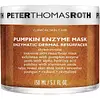What's inside
What's inside
 Key Ingredients
Key Ingredients

 Benefits
Benefits

 Concerns
Concerns

 Ingredients Side-by-side
Ingredients Side-by-side

Cucurbita Pepo
Skin ConditioningWater
Skin ConditioningPropanediol
SolventGlycerin
HumectantLactic Acid
BufferingLonicera Japonica Flower Extract
Skin ConditioningDehydroxanthan Gum
Emulsion StabilisingGluconic Acid
Hydroxypropyl Methylcellulose
Emulsion StabilisingSodium Hydroxide
BufferingLonicera Caprifolium Flower Extract
PerfumingPotassium Sorbate
PreservativeSodium Gluconate
Skin ConditioningParfum
MaskingEugenia Caryophyllus Leaf Oil
MaskingThymol
AntimicrobialMentha Piperita Leaf Extract
Skin ConditioningOriganum Vulgare Leaf Extract
Skin ConditioningRosmarinus Officinalis Leaf Oil
MaskingLavandula Angustifolia Oil
MaskingCitrus Limon Peel Oil
MaskingHydrastis Canadensis Root Extract
MaskingOlea Europaea Leaf Extract
PerfumingCinnamomum Cassia Bark
Skin ConditioningSodium Chloride
MaskingGlyoxal
AntimicrobialCinnamal
PerfumingCucurbita Pepo, Water, Propanediol, Glycerin, Lactic Acid, Lonicera Japonica Flower Extract, Dehydroxanthan Gum, Gluconic Acid, Hydroxypropyl Methylcellulose, Sodium Hydroxide, Lonicera Caprifolium Flower Extract, Potassium Sorbate, Sodium Gluconate, Parfum, Eugenia Caryophyllus Leaf Oil, Thymol, Mentha Piperita Leaf Extract, Origanum Vulgare Leaf Extract, Rosmarinus Officinalis Leaf Oil, Lavandula Angustifolia Oil, Citrus Limon Peel Oil, Hydrastis Canadensis Root Extract, Olea Europaea Leaf Extract, Cinnamomum Cassia Bark, Sodium Chloride, Glyoxal, Cinnamal
Water
Skin ConditioningCucurbita Pepo
Skin ConditioningAlumina
AbrasiveGlycerin
HumectantTriethanolamine
BufferingCarbomer
Emulsion StabilisingLactobacillus/Pumpkin Fruit Ferment Filtrate
Skin ConditioningSodium Lactate
BufferingAscorbic Acid
AntioxidantTocopheryl Acetate
AntioxidantRetinyl Palmitate
Skin ConditioningBHT
AntioxidantSodium Hyaluronate
HumectantLeuconostoc/Radish Root Ferment Filtrate
AntimicrobialHelianthus Annuus Seed Oil
EmollientCitric Acid
BufferingDisodium EDTA
Benzoic Acid
MaskingSorbic Acid
PreservativePotassium Sorbate
PreservativeSodium Benzoate
MaskingChlorphenesin
AntimicrobialPhenoxyethanol
PreservativeBenzyl Alcohol
PerfumingCinnamal
PerfumingParfum
MaskingWater, Cucurbita Pepo, Alumina, Glycerin, Triethanolamine, Carbomer, Lactobacillus/Pumpkin Fruit Ferment Filtrate, Sodium Lactate, Ascorbic Acid, Tocopheryl Acetate, Retinyl Palmitate, BHT, Sodium Hyaluronate, Leuconostoc/Radish Root Ferment Filtrate, Helianthus Annuus Seed Oil, Citric Acid, Disodium EDTA, Benzoic Acid, Sorbic Acid, Potassium Sorbate, Sodium Benzoate, Chlorphenesin, Phenoxyethanol, Benzyl Alcohol, Cinnamal, Parfum
 Reviews
Reviews

Ingredients Explained
These ingredients are found in both products.
Ingredients higher up in an ingredient list are typically present in a larger amount.
Cinnamal is an aromatic aldehyde. It is naturally occurring in the spice known as cinnamon.
Cinnamal is a known EU allergen, meaning it may cause an allergic reaction when applied to the skin.
Cucurbita Pepo is a species that includes the classic orange pumpkin, zucchini/courgettes, and various edible squashes.
These pumpkins and squashes are rich in vitamins, minerals, antioxidants, and alpha-hydroxy acids (AHAs).
Glycerin is already naturally found in your skin. It helps moisturize and protect your skin.
A study from 2016 found glycerin to be more effective as a humectant than AHAs and hyaluronic acid.
As a humectant, it helps the skin stay hydrated by pulling moisture to your skin. The low molecular weight of glycerin allows it to pull moisture into the deeper layers of your skin.
Hydrated skin improves your skin barrier; Your skin barrier helps protect against irritants and bacteria.
Glycerin has also been found to have antimicrobial and antiviral properties. Due to these properties, glycerin is often used in wound and burn treatments.
In cosmetics, glycerin is usually derived from plants such as soybean or palm. However, it can also be sourced from animals, such as tallow or animal fat.
This ingredient is organic, colorless, odorless, and non-toxic.
Glycerin is the name for this ingredient in American English. British English uses Glycerol/Glycerine.
Learn more about GlycerinParfum is a catch-all term for an ingredient or more that is used to give a scent to products.
Also called "fragrance", this ingredient can be a blend of hundreds of chemicals or plant oils. This means every product with "fragrance" or "parfum" in the ingredients list is a different mixture.
For instance, Habanolide is a proprietary trade name for a specific aroma chemical. When used as a fragrance ingredient in cosmetics, most aroma chemicals fall under the broad labeling category of “FRAGRANCE” or “PARFUM” according to EU and US regulations.
The term 'parfum' or 'fragrance' is not regulated in many countries. In many cases, it is up to the brand to define this term.
For instance, many brands choose to label themselves as "fragrance-free" because they are not using synthetic fragrances. However, their products may still contain ingredients such as essential oils that are considered a fragrance by INCI standards.
One example is Calendula flower extract. Calendula is an essential oil that still imparts a scent or 'fragrance'.
Depending on the blend, the ingredients in the mixture can cause allergies and sensitivities on the skin. Some ingredients that are known EU allergens include linalool and citronellol.
Parfum can also be used to mask or cover an unpleasant scent.
The bottom line is: not all fragrances/parfum/ingredients are created equally. If you are worried about fragrances, we recommend taking a closer look at an ingredient. And of course, we always recommend speaking with a professional.
Learn more about ParfumPotassium Sorbate is a preservative used to prevent yeast and mold in products. It is commonly found in both cosmetic and food products.
This ingredient comes from potassium salt derived from sorbic acid. Sorbic acid is a natural antibiotic and effective against fungus.
Both potassium sorbate and sorbic acid can be found in baked goods, cheeses, dried meats, dried fruit, ice cream, pickles, wine, yogurt, and more.
You'll often find this ingredient used with other preservatives.
Learn more about Potassium SorbateWater. It's the most common cosmetic ingredient of all. You'll usually see it at the top of ingredient lists, meaning that it makes up the largest part of the product.
So why is it so popular? Water most often acts as a solvent - this means that it helps dissolve other ingredients into the formulation.
You'll also recognize water as that liquid we all need to stay alive. If you see this, drink a glass of water. Stay hydrated!
Learn more about Water